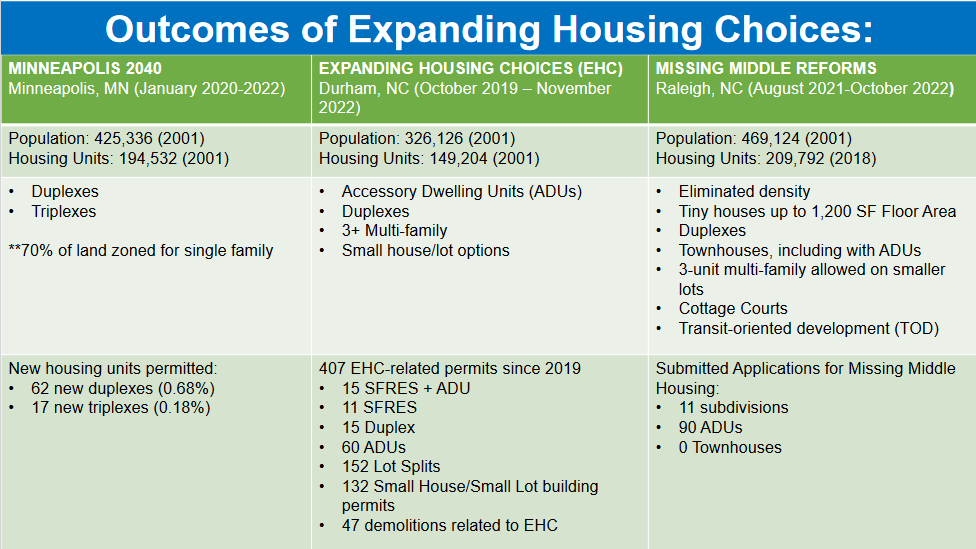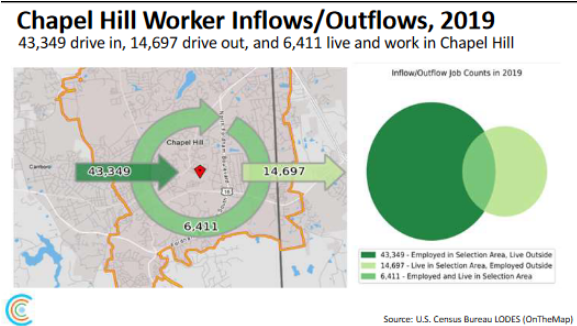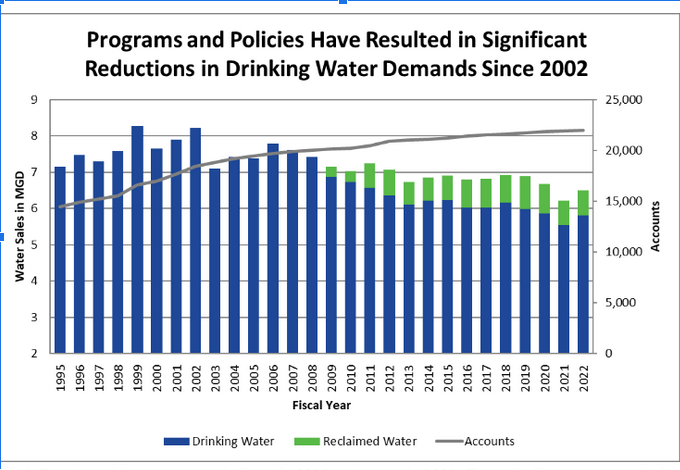Last week, the Town of Chapel Hill’s planning staff hosted two public info meetings about missing middle housing. Ever since, emails have trickled into the town inbox filled with fearmongering predictions about gentle density – which, if implemented, is one tool that will help address Chapel Hill’s shortfall in housing supply for young families and senior citizens.
First, a word about missing middle housing. It’s not going to solve every housing issue we have – and it’s not going to give us $150,000 condos. But it is part of a comprehensive strategy to include more opportunities for housing ownership in Chapel Hill, and a way to create more flexibility — for seniors who want to downsize or for young families hoping for their first starter home. Exclusionary zoning laws have an ugly history in our country, and have created persistent inequities.
Missing middle housing is modest in scale and blends well into existing neighborhoods — and it already exists in many of our older neighborhoods. As Geoff Green pointed out, missing middle houses like duplexes will remain “house scale” and blend into existing single-detached neighborhoods — regulations like lot size, minimum width, minimum setbacks, maximum height, and impervious surface will not change.
Many of the arguments against housing reforms have been rebutted, even though they come up in almost every community contemplating these changes. In Arlington, VA, in Madison, WI, in Portland, OR, in the Bay Area — the list goes on. A recent op-ed in the Washington Post counters some of the more common arguments made against missing middle: “Economists have found that new housing relieves pressure from competition that spikes the cost of more attainable units. New houses of all types temporarily reduce local tree canopies, but trees are also a regional concern, driven by loss of forests in expanding outer suburbs. Limiting exurban sprawl driven by a lack of housing near job centers and reducing long commutes by car are important for fighting climate change.”
We want to answer some additional questions that have been raised over the past week by concerned homeowners, many of whom have arrived in Chapel Hill decades ago when it was possible to purchase a home on a UNC junior faculty member’s salary.
With these new changes, can I rent out one of my bedrooms to a college student?
Yes, you can actually do that right now if you want.
Won’t my neighborhood be overrun by students?
As we have discussed elsewhere, UNC is not growing as quickly as some presume and some of the existing and future growth is taking place from online-only students who don’t live here. Still, students need places to live.
But in all likelihood, undergrads want you as a neighbor as much as you want them as a neighbor—i.e., not at all. They want to live near campus and near their friends and in places with walkable amenities. That means they will continue to stuff themselves into dorms and student apartments in and around downtown and in large apartment buildings with easy transportation options to campus.
It is possible that some grad students and medical residents and medical fellows will become your neighbor. Anecdotally, there are several grad student rentals in Stephen’s neighborhood and honestly they could benefit from a raging keg party now and again. They mostly seem too stressed and busy to be a bother.
These won’t be owner occupied.
Some will and some won’t be. It is very common for a homeowner to build or purchase one of these structures, live in one of the units, and rent out the others. This is no different than what a number of current Chapel Hill residents do, which is own homes in town in addition to their residence and rent them out.
It is also common for multi-generational families to purchase these: the grandparents live next door and can help with childcare, but have their own residence and privacy.
What about developers who want to maximize profits?
We point you to this excellent New York Times piece on starter homes in which home builders talk about how much they’d love to build smaller, starter homes.
The article focuses on the decline in the construction of starter homes in America – i.e., relatively small and affordable homes that enable young middle-class families to grow and build wealth. Several factors have contributed to the decline:
This mix of good intentions (energy efficiency, tree preservation) and exclusionary ones (aesthetic mandates, minimum lot sizes) has pushed up the cost of building on top of the rising cost of land. Cities have also shifted more of the burden for funding public infrastructure like parks and sewer systems off taxpayers and onto homebuilders.
The result today is that a builder who can put up only one home on an expensive piece of land will construct a large, expensive one.
Sound familiar? In most of Chapel Hill, it is currently impossible to build anything other than single-family homes – an intentional and exclusionary policy choice that is baked into our land use management ordinance.
To currently build anything other than single-family homes in Chapel Hill, including relatively affordable townhomes and condos, developers must participate in a protracted costly development review process and try to accommodate the requests of various advisory boards and Council members for community benefits taxpayers want but don’t want to pay for, like parks, sidewalks, and dedicated affordable units. (No such demands are placed on developers of McMansions).
As the article suggests, under the existing scheme, developers have no incentive to build anything other than expensive single-family homes.
Reforming our zoning laws allows for more density, which can make it easier and more profitable for developers to build smaller homes — and build the types of homes that gentle density would accommodate.
What guarantees can be provided that large, mature trees on redeveloped lots will not all be cut down and replaced with small saplings?
The same guarantees that apply when a single-family home is torn down and replaced with a newly built-but-larger single-family home will apply to a newly built duplex. (You may not realize this, but homeowners can generally remove as many trees on their property as they like. The tree protection ordinance doesn’t prevent that.)
The town is requiring minimum canopy coverage for triplex, fourplexes, and cottage courts.
Won’t any new homes be built by giant corporations?
Nationally, about half of new homes are built by the 100 largest builders. To achieve economies of scale, large home builders want to mass produce homes in greenfield developments, not small infill projects that would be allowed in Chapel Hill. It’s more likely that new missing middle homes will be designed and built by the same local architects and home builders that presently build new single family homes here.
But $400,000 condos aren’t cheap.
Land here is scarce and expensive. Condos in every market where they coexist with single-detached homes are cheaper than those single-detached homes.
This isn’t going to solve every single one of our housing problems — many solutions will be needed. But this is a critical initial step.
This is going to quickly change my neighborhood, isn’t it?
Several communities have implemented policies similar to Chapel Hill’s housing choices proposal, and the pace of change has been slow—frankly, a bit slower than most of us BlogBloggers would prefer. (Data from Minneapolis and Raleigh shows that changes have been very modest.)

One of the key issues is that our land-development system is good at building two kinds of homes — single detached homes on an individually owned lot, and large apartment buildings. There are well-oiled systems set up to manage the purchase and subdivision of large tracts of land into individually owned lots with homes that are sold to individual homeowners, and to provide individuals with mortgages to purchase the property. Likewise, banks have a lot of experience working with developers to finance the construction of large apartment buildings. But because there are few duplexes, triplexes, and quadplexes being built these days, it can be trickier to get financing to build one, or to get a mortgage to buy a single unit in a multi-unit property. So the pace of any change will be slow.
(Full disclosure — the brother-in-law of a BlogBlogger lives in Rhode Island and owns a triplex and rents out the two smaller units. The building was built in 1900).
Can our roads handle new residents?
Tinkerbell Lane isn’t going to become a nonstop traffic jam if a few duplexes are constructed. The roads on which most traffic congestion occurs are the major roadways like Fordham Boulevard/15-501 and Martin Luther King Jr. Blvd, both of which are major regional routes and which accommodate the housing growth north and south of our region that is commuting through or to Chapel Hill.
A few duplexes here and there are a drop in the bucket compared to the large single-family subdivisions sprouting up in Chatham County. Right now, more than 43,000 people commute into Chapel Hill for work. New housing types will allow more people who work in Chapel Hill to live in Chapel Hill, which has been shown to reduce vehicle trips and emissions.

Do we have sufficient electricity for these new residents?
Yes. In North Carolina, most population growth is taking place in a few areas across the state — the Triangle, Charlotte region, and Wilmington region. Duke Energy is addressing these power needs through grid modernization across the state. (Their biggest customers are data centers and healthcare — a few duplexes that are modest in scale and blend into existing neighborhoods is not going to break a sweat.)
(The concern about electricity seems to us like throwing [bleep] at the wall in hopes there’s some issue that will stick. Yes, the rolling blackouts from the recent cold snap are a concern, but that’s a multi-state issue that has nothing to do with whether there’s more development, or more dense development, in Chapel Hill.)
Do we have sufficient water?
Yep. Water usage in Chapel Hill and Carrboro has been declining since OWASA implemented tiered conservation rates – meaning using more water costs more – and the reclaimed water plant was put online in 2009. There is ample evidence that our community will be able to meet drinking water demand.

Will quads allow 16 cars to park there?
No. The only change that is being made is allowing more housing types on a lot. Nothing else is changing. New triplexes and quads in R1 and R2 zoning districts will be restricted to the same impervious surface requirements as current single family homes. New triplexes and quads in R1 and R2 zoning have the same restrictions on floor area ratio (FAR) which is the ratio of indoor roofed space to the entire lot. The newly allowed buildings can’t occupy more space than what is currently allowed and the parking infrastructure can not be greater than what is currently allowed.
Furthermore, if these new, higher density buildings are built on lots that abut high use transit corridors like MLK Boulevard, there is a possibility that not every adult resident will have a car, which may reduce parking demand relative to single family only housing. Keep in mind that there are currently over 1,200 households in Chapel Hill that do not have a car, and not just homes on or adjacent to campus – for example, the block group that includes Timberlyne has 120 households without a car and the block group that includes the American Legion property has 100 households with no car (American Community Survey, 2016-2020). (And at least one BlogBlogger is in a one-car household — there are many of us!)
Can Chapel Hill continue to add housing units in the coming years without a top limit being reached and without eventually getting rid of all natural areas except for some paved greenways with a few trees on either side?
On most of the land in town, the LUMO allow only single-family dwellings. If we are limited to building only single-family detached homes, then a lot of land will be required to accommodate more of the residents who are moving to North Carolina and want to live in a great community like Chapel Hil. Given the cost of land in Chapel Hill, those residents are more likely to be wealthy, and these homes are likely to be expensive. Allowing smaller housing units that consume less land will help preserve the natural resources we all treasure.
Could Chapel Hill try this out by rezoning one neighborhood and seeing the impacts?
That would mean that there would be only one location in town where this type of missing middle housing is allowed. If it’s popular, the fact that it’s only allowed in one location will likely drive up prices. Localized upzonings run a higher risk of increasing property values in the affected areas, as Durham native Yonah Freemark has demonstrated.
Did the people who asked these questions look like our Chapel Hill community?
No. In last Wednesday’s missing middle housing meeting, all 36 attendees self-identified in voting records or other governmental records as white. (Chapel Hill is 70% white.) 33 attendees were confirmed home owners — over 50% of Chapel Hill residents rent. Many of the attendees purchased their home decades ago.
This aligns with the research that Katherine Einstein, David Glick and Maxwell Palmer did looking at what they call neighborhood defenders — “We find that individuals who are older, male, longtime residents, voters in local elections, and homeowners are significantly more likely to participate in these meetings. These individuals overwhelmingly (and to a much greater degree than the general public) oppose new housing construction. These participatory inequalities have important policy implications and may be contributing to rising housing costs..”
Why are you excited about missing middle?
We’re excited because we love living here, and we’re watching more and more people struggle to find housing or stay here.
As we wrote earlier, “In effect, we have outlawed the starter home, which was a rite of passage for so many of our parents and grandparents. We are forcing young families to either rent where jobs and good schools are located, or buy an affordable home so far from areas of opportunity that they will spend countless hours driving.
Where we live shapes much of our lives — from our commute times to where our kids can attend school. Allowing for a range of housing choices means more people can share in the opportunities we have in Chapel Hill.”
This piece was written by Melody Kramer, Geoff Green, John Rees, Stephen Whitlow, David Anderson, and Martin Johnson.